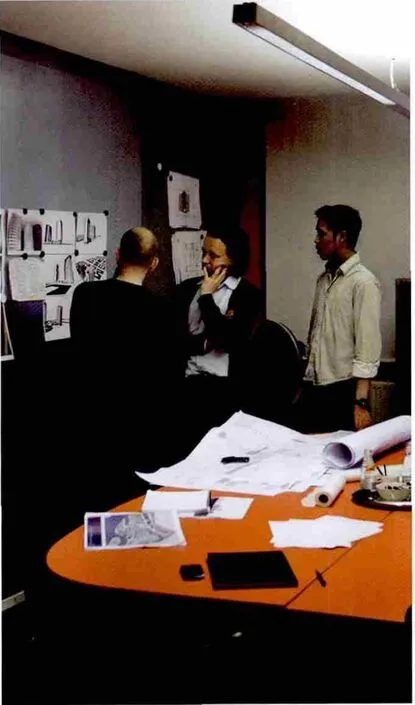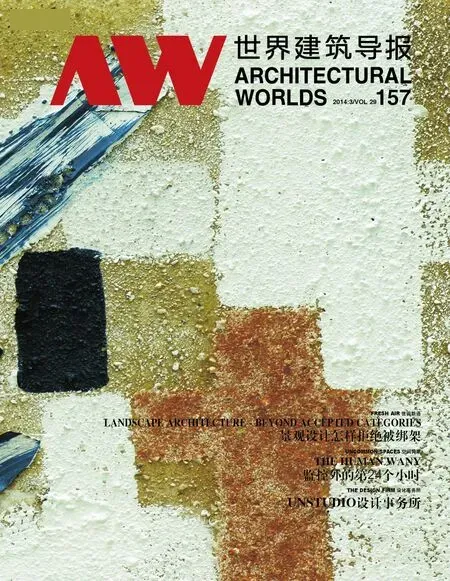设计资本—如何分六步(或多或少)完成联合设计
2014-04-25作者AuthorCarolineBos
作者Author: Caroline Bos
如今,建筑设计原则正迎接着由巨变带来的可能性。在过去数十年间,收获与成长是我们在建筑行业中的真实写照,并推动了该行业的正规化及发展,但是,目前一切都变了。如今人们关注的是在核心领域中对几乎全部重要注意事项进行清晰阐述。任何事,是的,任何事都会改变——整个世界面临着巨大的挑战和需求。
意识到这一挑战的存在也就意味着意识到了其蕴含的潜力;建筑业亟需创新。没有持续性的材料、文化和理念创新,这一领域就会失去其特殊性,进而沦为普通建筑行业中乏善可陈的一部分。而在UNStudio的帮助下,我们早已意识到了上述危机,这也是我们不断开拓新领域、不断迎接挑战并解决问题的原因。但是,与此同时,这种实验性质的态度也促使我们承建尽可能多的建筑。在经济全球化过程中,脱离建筑行业从来都不是我们的本意。
因此,我们积累了大量经验和与实践相关的知识。正是这些丰富的知识和经验构成了我们的设计资本。我们如何使用它?我们如何保存、分享并拓展我们的知识?需要强调的是,这些知识是我们在全球各地针对不同规模、不同类型的好几百个项目开展设计的过程中不断积累的——它们都是独一无二的建筑设计知识,而不是随随便便就能够在互联网上找到的。目前,UNStudio制定了两种策略用于应用并宣传其设计资本。在内部用三年时间进行了四个知识平台的建设之后,我们于2013年6月发布了开放资源知识网络。此外,我们还在设计过程中充分运用了我们的经验和训练有素的判断力。
本文旨在关注我们在改进设计的过程中使用设计资本的方法,通过这些方法我们使设计变得更加智能、更加简洁。借鉴经验使设计过程最优化,这不单单关乎效率。如今,基于目前的需求情况和问题意识的情况来看,设计资本还能够同时确定需要解决的主题并使它们相互联系。这些主题包括:知识、文化和经济价值、健康和社会。我们该如何重新认识这些主题呢?我们该如何在建筑的内生性和外生性这两个永恒的价值观之间寻找平衡呢?
步骤一:确定目标
当我们开始一个新项目,开始着手新的设计时,我们并非从第一天开始。实际上,UNStudio自6.395天前就已经开始了,而对客户来讲新项目可能在478天前或8.201天前才能算做正式开始。上面的数字只是几个任意数,但是重要的是我们并不是从头开始;作为一个团队、一个整体、一个承担着高风险的企业,作为建筑师,我们通常比我们的意识更为超前。UNStudio有其自身关于设计的长远目标和短期目标,我们在开始一个新项目时总会铭记这些目标;实际上它们已经融入了我们的行动之中。
但是,客户的目标又是什么?问题背后还隐藏着什么问题?项目的主题到底是什么,在特殊情况下什么才是最为必需的?在这个特别摘要中,我们必须努力寻找需求的核心。答案肯定会让人大吃一惊;核心可以是一面光滑平整的白墙,可以是想要提升所购买地块价值的渴望,也可以是城市连接设施的创造——任何事物都有可能,而我们必须透过明显的表象看清事物的本质。
步骤二:了解现状
这看上去很容易,其实不然。什么是“现状”?一个常用的词是环境;建筑师通常将这个词释义为未知地点的物理环境、位置及布局。有时分析物理环境可能是件好事;而有时其可能会因过度研究,而研究中得到的新材料又毫无意义而造成了巨大浪费。我们需要意识到这一点,并避免盲目的重复性工作,但是更为关键的一点是,我们需要将环境作为一个整体来考虑。一个具体的环境地点从哪儿开始又从哪儿结束?在大部分环境中可以使用全球定位技术,而这却引发了各种各样的问题与争论,从本地到全球的争论再到考古学和生物学领域的争论,从政治领域到能源领域的争论等等。环境概念所涉及的要远远超过地点的物理性概念,因此需要使用更为包容性的和更为模糊的术语。
了解现状指了解不只是我们需要领悟的现状本身,因为我们总是抓不到它的真谛;我们管控现状的唯一途径就是与之互动。在《存在与事件》的导言中,哲学家阿兰·巴迪欧将现状描述为“纯粹冷漠的多样性”。通常不能标准地把握现状。它就是它,存在于复杂的形式。因此我们将自身浸入既定的现状中,不存任何期望或偏见,领悟它的各个方面——也许最多只能领悟五分之三——我们可以从这些方面着手,将我们的知识和创造力应用其中,使我们可以成为(仍引用巴迪欧的原话)“寻求真理的激进分子”。这些方面的确可以涉及物理环境、现在与未来、社会建设,或更广范围的、令人难以置信的各种各样的现象,如“中国”或“多功能设计”这两个当代的现状。
步骤三:其他人的角色;网络、机遇与风险
我们并不是唯一从事这项事业的人,而且接下来要发生的事情也不只由我们来决定。布鲁诺·拉图尔(Bruno Latour)称,在一个网络中你可以只做一名演员,对于建筑师来说这一点当然也同样适用。身处一个网络之中,你就必须与其他人相互接触;说服他们同意你的理念并认同你的目标,并劝说他们支持你。但是,就在我们试图“招募”其他人的同时,其他人也在做着同样的事情。通常情况下我们在比赛中总是与其他演员处于竞争的关系。我们的竞争者会怎么做?他们的制胜策略又会是什么呢?
然后就会发现有些重要的其他人正处于委任我们的地位;关于他们的具体位置,我们知道多少?我们可以展开四点(优势、劣势、机会、威胁)分析,试着找出这个网络中较强的组织和较弱的组织,并据此找到我们前进的道路。
步骤四:命名
为一个新型的具备复杂性的多层面事物命名从来都不是一件容易的事情,但有些时候,明确表达概念能够帮助深化设计的过程。这一名称必须是一本可扩展的、摆在作者与读者之间的“打开的书”。命名需要指示,明确方向,并激发一些灵感;与此同时还要为下一阶段的设计留出机遇,留出未来的机会,并为其提供信息和知识的新来源。正如婴儿一样,随着时间的流逝,他会向着他名字指引的方向成长。
命名是一种交际行为;我们告诉其他人我们所想的是关于这个项目、这个建筑潜在工作的主题。我们选择,我们编辑;我们创造捷径。我们迫使自己尽可能在这早期阶段保持思维明确。某些时候,在生活中人们会更改他们的名字,而这也是可以接受的。
步骤五:新的重大细节
目前,设计过程通常都十分短暂;相比十年前来说这一过程所用的时间至少缩短了百分之三十。对于客户来说有经济上的压力,这种压力迫使客户迅速推进交流对话。因此必须改进我们的散漫模式,并采用速记法。一切维持正轨的方法就是预先选取与项目有关的一些特色,并保证速度。我们在过去的三年间不停地将这些特色投入实验。这些特色与大规模的、典型空间的构造或外观发展相关,这些发展表明设计主题仍在不断进化。
黑龙江省不同地区存在普惠金融程度不同的问题。对于普惠金融程度差的地区,金融资源供给不足的地区,加强金融机构的引进和重组。首先对农村涉农金融机构进行整合,形成以国有大型商业银行为领头,农村信用社、村镇银行等新型农村金融机构的多层次的普惠金融体系。比如中国农业银行作为大型国有商业银行,它的资金实力、业务范围、产品创新能力都要优于其他小型银行,在解决普惠金融问题上的作用不可替代。因此,农业银行要承担起支农惠农的责任,农业银行的营业网点要保留到乡镇,在农村金融市场不能完全退出。农业银行应和农村信用社等农村金融机构一起发挥支持县域经济发展的重任,带动提高整个农村金融体系的服务水平。
步骤六:后象
UNStudio一直都对建造可以提供多重视角的分层浇筑建筑十分感兴趣。我们不断进行新的设计选择,促进多样性的发展,如:非对称性、非笛卡尔几何学、可以首尾相连的“无尽的”空间组成、“视差经历”以及莫尔效应等。这也是我们目前仍在做的,因为我们要创造激动人心的环境,在你每次看到时,它们都会激发出不同的视角。这就是“打开的书”,需要由使用者自己去发现、去探索。通过互动与激励,这也产生了社会效应。
在开始一项新的设计时,我们都会问自己一个问题:这座建筑中的后象的主中心是什么?我们需要怎样做才能取得最大的共鸣呢?
结论
设计技巧仍然极具价值。但是如今最重要的是,以专注且更具目标指向性的方法应用设计资本。机会之窗很窄;在快速选择并在主题与事件(与其社会、经济、可持续性和/或其他方面有关)之间进行互动并进行空间呈现的过程中,训练有素的判断十分重要。以某种非确定的或规范的方法将设计过程结构化,就有了上述六个步骤。
Today, the discipline of architecture is wide open to the possibility of radical change. The narratives of gain and growth that explained, legitimized and propelled forward so much architecture in the past decades have been interrupted. The focus now is on articulating new conceptualizations of possibly all the vital considerations at the core of the field. Everything, yes everything, can change – the problems and needs the world collectively faces are that big.
Awareness of this challenge also entails understanding its beneficial potential; architecture thrives on newness. Without continuous material, cultural and ideological innovations, the profession loses its specificity and becomes simply a bland part of a generic building industry. With UNStudio we have long realized this, which is why we have pushed ourselves in many different directions, continuously addressing new challenges and questions. But at the same time this experimental attitude has also led us to consciously seek to build as much as we could. Disengagement from the dangers of the building industry within the globalized economy has never been our preferred option.
As a result, we have amassed a huge amount of experience and practicerelated knowledge. It is this wealth of knowledge and experience that constitutes our design capital. How do we utilize it? How do we preserve, maintain, share and expand our knowledge? This is knowledge, it should be emphasized, that has been laboriously gained by working through numerous design phases on hundreds of projects of all scales and typologies in all parts of the world – it is completely unique design-related architectural knowledge, not something you just come across everywhere on the internet. Presently, UNStudio foresees two strategies to handle and propagate its design capital. In June 2013 we will launch an open source knowledge network, after having worked for three years internally on the development of four knowledge platforms. Besides this, we apply our experience, our trained judgment, to our project design process.
This text focuses on ways to use design capital to improve the design process, to make it more intelligent and more concise. Yet drawing on past experience to optimize the design process is not merely a question of efficiency. Now, in the current climate of need, and of problem awareness, design capital can also serve to identify and interconnect the topics that need to be addressed.




These topics are: knowledge, cultural and economic values, health, and society. How do we begin to understand these anew? How can we find a new balance between timeless values endogenous and exogenous to architecture?
Step 1: Identifying Goals
When we begin a new project, a new design, we do not start on day one. Actually, it is already day 6.395 for UNStudio, and for the client it may be day 478, or it may be day 8.201. The number is arbitrary, but what matters is that we do not start at the beginning; as a team, as a collective, as a highly risky enterprise, we are much further along than we often realize as architects. UNStudio has its long-term goals and shorter-term goals relating to design, which we take with us when we start the new project; they are already given.
But what are the goals of the client? What is the question behind the question? What is the project really about, what is really needed in a particular situation? We must try to discover what is at the core of the demand for this particular brief. The answer may be a surprise; it can be an image of a smooth white wall, it can be the desire to raise the value of the purchased plot, it can be the creation of an urban connection – anything is possible, and we must look beyond the obvious.
Step 2: Understanding the Situation
This is something that seems easy, but is not. What is a ‘situation’? A word often used is context; primarily architects interpret this to refer to the physical context, the position and lay-out of the location in question. Sometimes analyzing the physical context can be a good thing to do; sometimes it has already been exhaustively researched and the production of additional material is meaningless and wasteful. We need to be aware of this and avoid mindless repetition, but more crucially even we need to question to whole notion of context. Where does a context begin and end? Global positioning is a factor in many if not all locations, and this evokes all sorts of questions and debates, from local-global arguments, to archeology and biography, and politics and power. Context thus clearly pertains to far more than the physical aspects of the location, and therefore the more inclusive and ambiguous term situation is preferred.
Understanding the situation means understanding that is not the situation itself that we need to comprehend, because aspects of it will always remain outside our grasp; the only way we can manage a situation is by interacting with it. In the introduction of ‘Being and Event’ the philosopher Alain Badiou describes situation as ‘pure indifferent multiplicities’. A situation cannot usefully be approached normatively. It is what it is, in a complex way. Therefore we immerse ourselves in the given situation without expectation or prejudice, and extract from it some aspects – maybe just two to five at the most – which we can act on, to which we can apply our knowledge and creativity, which allow us to be (again in the words of Badiou) ‘militants of truth’. These aspects can indeed relate to the physical surroundings, now or in the future, to a social construction, or to a larger, implausibly multifarious phenomenon such as ‘China’, or ‘mixed-use’ to name but two contemporary situations.
Step 3: The Role of Others; Network, Chance and Risk
We are not in this alone, and so what happens next is not up to us alone. Bruno Latour has claimed that you can only be an actor in a network, and for architects this certainly seems true. Being in a network entails binding others to you; convincing them of your ideas and aims, and persuading them to support you. But just as we aim to ‘enroll’ other actors, they do too. Often we are pitched against other actors in a competition. What will our competitors do, what is their probable winning strategy?



Then there are those vital others who are in a position to commission us; what is their position exactly, as far as we can tell? We may make a SWOT analysis to try to pinpoint the stronger and weaker tissues within the network, and try to find our way forward accordingly.
Step 4: Naming
To put a name to a multifaceted thing that is emerging out of sheer complexity is always difficult, but sometimes it is possible and helpful to further the design process by articulating a concept. This name must be proliferative, an ‘open text’ that is created between author and reader. Naming entails pointing, giving some direction, and laying down some aspirations, while at the same time leaving still much open to chance, future opportunities, and new sources of information and knowledge that will enter the process at a later stage. A baby will grow into its name over time.
Naming also is a communicative act; we tell each other what we think is a major topic within this project, this potential work of architecture. Thereby we choose, we edit; we create a shortcut. We force ourselves to make ourselves as clear as we can be at this early point in time. Sometimes, later in life, people change their name, and that is fine too.
Step 5: The New Big Details
Currently, the design process is usually very short; at least 30 per cent shorter than it was ten years ago. There is an economic pressure on the part of the client, which makes it necessary to move the conversation forward quickly. Our discursive mode must therefore develop some personal shorthand. What we can do to remain on course, while still maintaining speed, is to preselect some features that we have been experimenting with over the last three years, and that we feel are pertinent to the project. These features pertain to large-scale, defining spatial, constructional or façade-related recent developments that speak of design themes that are still evolving.
Step 6: After Image
UNStudio has always been interested in producing layered constructions that afford multiple viewpoints. We have consistently privileged design choices that would engender multiplicity, such as: asymmetry, non-Cartesian geometry, ‘endless’ spatial compositions that turn back on themselves, ‘parallax experiences’, and Moiré effects. And this is what we continue to do, in order to make inspiring environments that incite different perspectives each time you return to them, that are ‘open texts’ themselves, needing to be discovered and appropriated by the user, and that are socially relevant by being interactive and provocative.
Beginning a new design, we may ask ourselves the question: what will be the primary site for the after image in this building? Where are we aiming for maximum resonance?
Conclusion
Design skills are a valuable good still. But the most important issue today is the ability to apply design capital in a focused and goal-orientated way. The window of opportunity is narrow; the deployment of trained judgment is essential to quickly select and interconnect the spatial manifestations of topics and issues that are chosen for their social, economic, sustainable, and/or other relevance. Structuring the design process in a way that is not deterministic or prescriptive has led to the formulation of the Six Steps described above.
